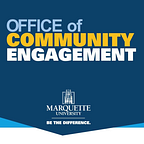Branding a beacon
What’s at the heart of a diverse suburb’s identity — and how is it best marketed to the world? A group of Marquette business students lead the effort to provide answers.
By Allison Dikanovic
Dr. Felicia Miller, a faculty member in the College of Business Administration, recognizes that members of the community around us can serve as some of the best co-educators. She takes every opportunity she can to create projects and assignments for her branding classes that engage her students with Milwaukee.
“With these projects in general, I want my students to get an appreciation for the world outside the Marquette bubble, or whatever bubble they were living in before that,” Miller said. “I try to push them regardless of race, creed or color, to get outside of whatever that bubble is and see the rest of the world.”
In the past, her classes have mostly worked with local nonprofit organizations on rebranding efforts, but when the Village of Brown Deer’s city planner reached out to her, she said she couldn’t pass up the opportunity to learn about the branding of a place. The class’s assignment was to partner with the Village of Brown Deer to develop a community brand identity that better reflects the reality of their community.
“It was so cool to get out and see and expand what I know and kind of expand where my comfort zone is,” said Charlie Murphy, a senior in the College of Business Administration.
The class set out to learn from members of the community and discover some of Brown Deer’s unique qualities. Their assignment consisted of two parts: analyzing information and data about the village to create a brand audit and producing a marketing plan with suggestions for how to promote the community’s identity.
Brown Deer is a suburb of Milwaukee and is considered one of the North Shore communities alongside Shorewood, Whitefish Bay, Fox Point, Bayside, Glendale, and River Hills. The city planner and village manager from Brown Deer said the village was having trouble attracting business and growth and did not seem to have a unified, cohesive place identity.
For their audit, Miller’s class analyzed data from focus groups the village had conducted, census data, state of Wisconsin crime data, and other primary and secondary sources.
“[Brown Deer] is a great place to live, and that’s supported by facts and what we wanted to show people,” Murphy explained.
Demographics have been changing in Brown Deer in recent years, and the community’s racial and ethnic makeup is diversifying. In a metro area often notorious for its segregation, Brown Deer is a relative rarity. The students identified that the village needed to fully embrace this diversity to have the most accurate and inclusive brand identity that would ultimately make their community stronger.
“You have this whole influx of African American and Hispanic middle to low middle income families, which is really good, as well as single people,” Miller pointed out from the students’ data. “You need to address everyone in your community, and then that will attract other people to your community.”
“Their biggest pull is their diversity,” Murphy said. “We thought that now, a lot of people are looking for diversity in their home lives, so that’s what we wanted to promote.”
The marketing plan part of the assignment gave the students the opportunity to creatively respond to what they found in the researching phase. They focused on how to engage members of the community, how to get people involved, and the kinds of businesses that would be best to attract. Miller said that the class’s recommendations placed a large emphasis on encouraging local and regional businesses to make a home in Brown Deer. She said they were excited and optimistic.
“The students were really great,” Miller said. “They were saying things like, ‘[Brown Deer] could be a beacon for the entire state of Wisconsin on how diverse people can live together happily.’”
Miller said the students realized that a new logo or updated website alone would not create the strongest possible brand for the village, but rather the goal would be much more intangible: to make all residents feel like they are essential to the community of Brown Deer. They recognized that community engagement and working to make sure the leadership is representative of all residents were important areas to focus on.
After their final presentations in front of the community development director and village manager, Miller compiled the students’ work into one 35-page document that she then presented to the Village of Brown Deer Board of Trustees.
Miller hasn’t had the opportunity to stay in consistent contact with the leadership in Brown Deer, but she said she hopes they took to heart what her students had to say.
“I think the students get a lot out of hands-on practice of all the stuff we’ve taught them in the classroom, but this project and a few others that I’ve done, I think had a real impact on the way they see the world,” Miller said.
Murphy agreed.
“This project was by far the most interesting assignment I’ve worked on at Marquette,” he said. “I definitely enjoyed moving out into the Milwaukee community to see how the work we were doing affected people in the real world.”
